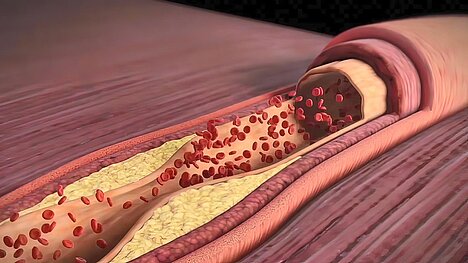Cholesterol level

Did you know that dogs also have cholesterol levels that can be too high or too low? In this article you will learn everything you need to know about cholesterol in dogs: what cholesterol is, how it is measured, the causes and consequences of high or low cholesterol levels and how you can help your dog to achieve an optimal cholesterol level.
What is cholesterol?
Cholesterol is a fat-like substance found in all cells of the body. It is important for the formation of hormones, vitamin D and bile acids, which help in the digestion of fats. Cholesterol is partly produced in the liver and partly absorbed through food. There are two types of cholesterol: the good HDL cholesterol, which removes excess cholesterol from the cells and takes it to the liver where it is broken down, and the bad LDL cholesterol, which is deposited on the walls of the blood vessels and can lead to arteriosclerosis.
How is cholesterol measured in dogs?
The cholesterol level in dogs is determined in the same way as in humans with a blood test. This involves measuring total cholesterol, HDL and LDL cholesterol and triglycerides. Triglycerides are another type of fat in the blood that can also contribute to cardiovascular disease. The normal cholesterol level in dogs is between 150 and 250 mg/dl. A value above 300 mg/dl is considered high and a value below 100 mg/dl is considered low.
What causes high or low cholesterol levels in dogs?
A high cholesterol level in dogs can have various causes. The most common are
- Obesity: too much fat in the body leads to more cholesterol in the blood.
- Diet: Too much fat or sugar in the diet can increase cholesterol levels.
- Genetics: Some dog breeds are more prone to high cholesterol than others. These include Beagles, Schnauzers, Labrador Retrievers and Golden Retrievers, for example.
- Diseases: Some diseases can disrupt cholesterol metabolism, such as diabetes mellitus, hypothyroidism (underactive thyroid), Cushing's syndrome (overproduction of cortisol) or kidney disease.
A low cholesterol level in dogs is rarer than a high one and can also have various causes. The most common are
- Malnutrition: too little fat or protein in the diet can lower cholesterol levels.
- Genetics: Some dog breeds have naturally low cholesterol levels, such as greyhounds or border collies.
- Diseases: Some diseases can lower cholesterol levels, such as hyperthyroidism (overactive thyroid), liver disease or malabsorption (impaired absorption of nutrients in the intestines).
What are the consequences of high or low cholesterol levels in dogs?
A high cholesterol level in dogs can lead to various health problems. The most important are
- Cardiovascular disease: A high LDL cholesterol level can constrict blood vessels and obstruct blood flow. This increases the risk of heart attack, stroke or high blood pressure.
- Pancreatitis: An inflammation of the pancreas that can lead to severe pain, vomiting, diarrhea and fever. A high triglyceride level is a risk factor for pancreatitis.
- Skin problems: High cholesterol levels can lead to dry, flaky or oily skin, which is more susceptible to infections or allergies.
Low cholesterol in dogs usually has no direct consequences, but can be an indication of an underlying condition that needs to be treated.
How can you help your dog achieve optimal cholesterol levels?
If your dog has too high or too low a cholesterol level, you should first speak to your vet to find out the cause and start appropriate treatment. In addition, you can help your dog to optimize his cholesterol level by following these tips:
- Watch your dog's weight: Obesity is one of the most common causes of high cholesterol. Try to give your dog a balanced and low-calorie diet and exercise him regularly. If your dog needs to lose weight, don't just give him less food, but use a special diet food that contains all the nutrients he needs.
- Pay attention to the quality of the food: Not only the quantity but also the quality of the food can influence the cholesterol level. Avoid food with too much fat or sugar and instead choose food with a high proportion of unsaturated fatty acids, fiber and vitamins. You can also use natural supplements such as salmon oil or flaxseed oil, which can increase good HDL cholesterol.
- Pay attention to your dog's health: Some diseases can alter cholesterol levels and need to be treated accordingly. Have your dog checked regularly by the vet and follow their instructions regarding medication or other measures. If your dog has thyroid or kidney disease, he may need a special diet to support his metabolism.
Cholesterol is therefore not only important for humans, but also for dogs. With a healthy diet, sufficient exercise and good veterinary care, you can help your dog to achieve an optimal cholesterol level and thus improve his quality of life and life expectancy.
The authors assume that a veterinarian should be consulted if an animal is ill and that medication should only be taken after consultation with a doctor or pharmacist. Only an individual examination can lead to a diagnosis and treatment decision.
We help you find the nearest vet → This way